Risk is currently tilted to the downside

Higher-than-expected inflation figures and signs of a weaker US economy sent equity markets tumbling late last week and early this week. The risk is still to the downside. The US volatility VIX index could be a good hedge.
Higher interest lowers stock prices
The S&P500 Index fell 1.7% from Wednesday, 15th February, to Friday, 17 February 2023. The main reason for the decline was that the US Producer Price Index showed that inflation rose by 0.7% (month-on-month) in the USA against expectations of 0.4%. In addition, the Philadelphia Fed index and Housing starts (indicator of privately owned new housing units) in the United States fell more than anticipated. However, earlier statistics showing a solid US labour market and retail sales point to a relatively strong US economy.
The 2-year US Treasury note yield bottomed out at 4.05% on 2 February and rose to 4.68% on 21 February. The bond market has raised expectations for the peak of US interest rates to around 5.20%.
On Wednesday, 22 February, at 20.00 CET, the Fed will release the minutes of its latest meeting. Given the recent macro data, the Fed minutes may indicate how much tightening the central bank’s members think is needed. On Friday, 24th February, the US Core Inflation for January will be released.
US 2-Year Treasury Yield (in %) in a one-year daily graph

The upward pressure on US yields, which raises investors' return requirements and thus puts pressure on equity prices, has yet to spread to HYG (US High Yield Bond ETF). The HYG is already under pressure but is trading above its all-time low of mid-October 2022. Although the change is minor, the bond market has become more willing to take risks since the turn of the year. Historically, the high-risk bond market (HYG) and the equity market (S&P500 index) have had a good price correlation.
HYG (in USD) in a one-year daily graph
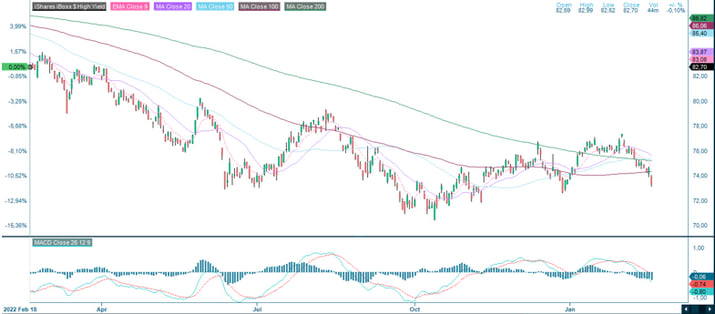
Q4 2022 Earnings Season slightly weaker than usual
As of 18 February 2023, 82% of S&P 500 companies have reported their Q4 2022 results. The number of better-than-expected earnings reports has declined to 68% from 69% a week ago. Meanwhile, better-than-expected revenue reports have increased to 65% from 63%. In the fourth quarter of 2022, the earnings decline for S&P 500 companies compared to Q4 2021 is 4.7%.
The S&P 500 sectors that have been most successful in beating analysts' Q4 2022 earnings forecasts are Information Technology (79% of Q4 earnings better than expected), followed by Health Care (74%) and Consumer Staples (71%). The worst performers are Energy (57%), Utilities (56%) and Commercial Services (45%).
In summary, the Q4 2022 reporting season, which is coming to an end, has been slightly weaker than an average season. The fact that 65 S&P500 companies (76% of those providing guidance) have forecast weaker performance in Q1 2023 reinforces this impression.
USD finds strength in rising rates
The USD has strengthened against the Euro as US interest rates rise. The EUR/USD is currently trading below support. The next downside level is around 1.05, where Fibonacci 38.2 is located. The MA100 is also currently at a level just south of Fibonacci 38.2.
EUR/USD, one-year daily graph
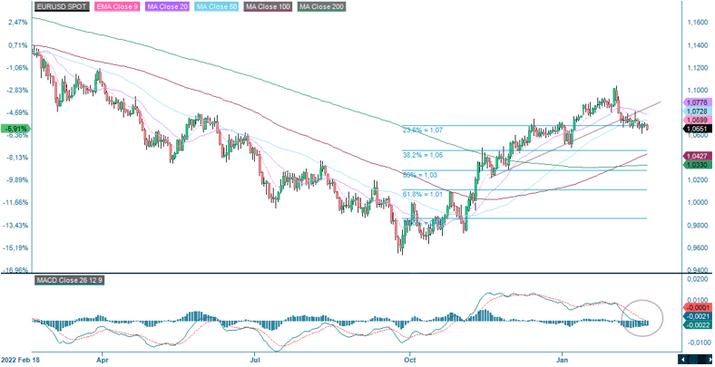
Below are instruments of USD per 1 EUR.
The MACD is about to give a weak sell signal for the EUR/USD on the weekly graph.
EUR/USD, weekly five-year graph

S&P 500 testing support. Risk to the downside
The S&P 500 is currently trading just below support at 61.8 Fibonacci. The next potential support level is near the rising trend line. However, the MACD has generated a weak sell signal. This suggests that the risk is on the downside in the shorter term.
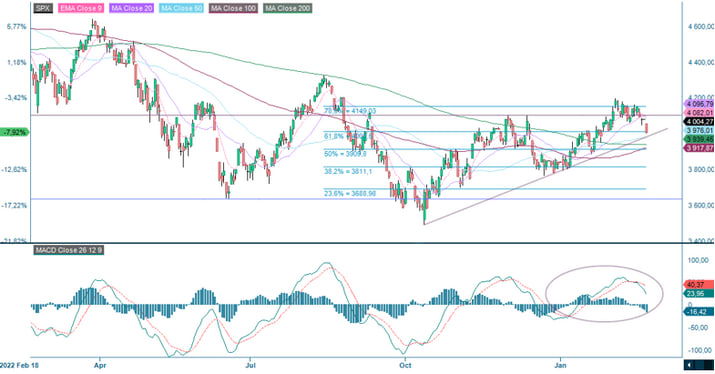
On the weekly graph, the index trades around a cluster of support levels. Momentum is losing steam, as the MACD histogram shows.
S&P 500 (in USD), weekly five-year graph

Nasdaq 100 currently below support
The tech-heavy Nasdaq 100 trades below support at Fibonacci 38.2 and MA20. The MACD has given a weak sell signal, with the next level at 11,912 and 11,690, where the MA200 meets.
Nasdaq 100 (in USD), one-year daily graph
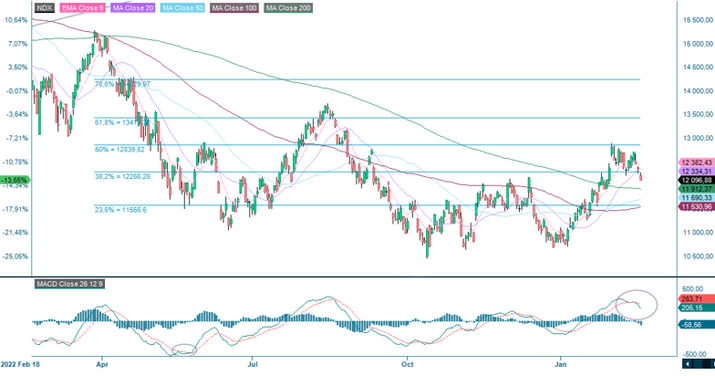
On the weekly graph, the support at 11,900 is reinforced by the Fibonacci 23.6 at the same level.
Nasdaq 100 (in USD), weekly five-year graph
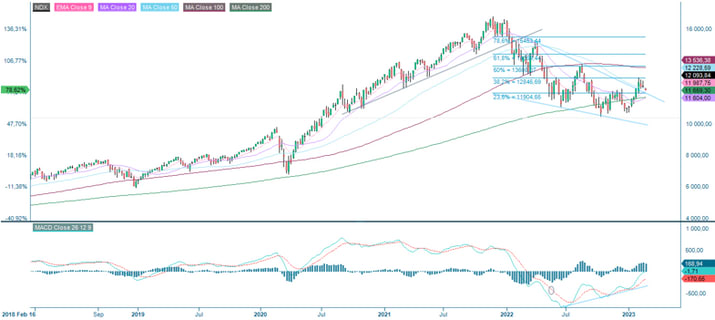
Downside risk also in Europe
The German DAX index is currently trading in a short upward-sloping trend. However, the risk is on the downside, as the US is trading weakly, and momentum is waning, as indicated by the MACD. In the event of a break, the next level to the downside is around 14,800, where both the MA50 and the Fibonacci 78.6 meet.
DAX (in EUR), one-year daily graph

In the weekly graph, the MACD histogram indicated falling momentum.
DAX (in EUR), weekly five-year graph

An asymmetric head-and-shoulders formation can be seen on the OMXS30. If the neckline breaks, the index could fall to 2,130. However, on the way down, the rising trend line and the MA50 must be taken out.
OMXS30 (in SEK), one-year daily graph

As for the DAX, the OMXS30 is losing momentum on the weekly graph, as illustrated by the MACD histogram.
OMXS30 (in SEK), weekly five-year graph

Case of the week: Probably a good time to buy protection
The US volatility VIX index may be a good hedge against the downside risk. The VIX, which reflects the perceived risk in the market (S&P500), recently fell below 19. This is a level where it usually makes sense to buy some protection. The low levels for the VIX suggest investors have become too complacent in the short term. As discussed above, rising interest rates and a lacklustre outlook for company earnings growth are potential headwinds for further broad gains in the stock markets.
In the graph below, we illustrate how, in contrast, put options on the S&P500 have become relatively more expensive compared to call options in recent months. The so-called “skew “ and the CBOE Skew Index (calculated based on S&P500 options) has risen since November 2022. At the same time, the implied volatility (VIX) has been falling. If put option buyers are right, markets will go down, and the implied volatility should rise. Accordingly, the VIX should bounce back in that scenario.
VIX Index (both in USD), vs SKEW Index, one-year daily graph

The VIX index has started rising since the beginning of February 2023. There is a positive divergence and a buy signal in MACD. The MA200 level at 24.8 is a natural target.
VIX index (In USD), one-year daily graph
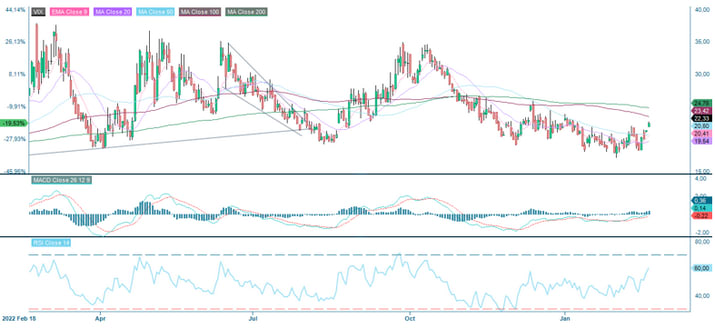
VIX (In USD), weekly five-year graph
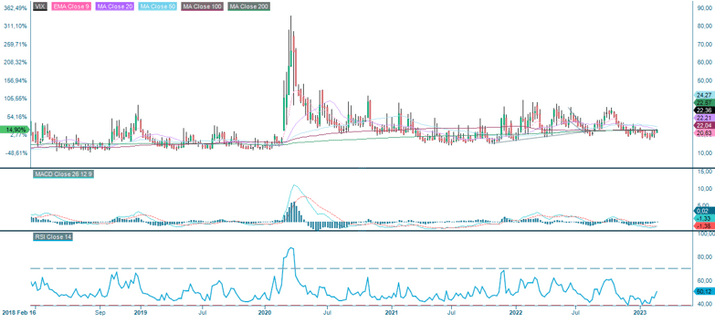
The full name for abbreviations used in the previous text:
EMA 9: 9-day exponential moving average
Fibonacci: There are several Fibonacci lines used in technical analysis. Fibonacci numbers are a sequence of numbers in which each successive number is the sum of the two previous numbers.
MA20: 20-day moving average
MA50: 50-day moving average
MA100: 100-day moving average
MA200: 200-day moving average
MACD: Moving average convergence divergence
Risks
External author:
This information is in the sole responsibility of the guest author and does not necessarily represent the opinion of Bank Vontobel Europe AG or any other company of the Vontobel Group. The further development of the index or a company as well as its share price depends on a large number of company-, group- and sector-specific as well as economic factors. When forming his investment decision, each investor must take into account the risk of price losses. Please note that investing in these products will not generate ongoing income.
The products are not capital protected, in the worst case a total loss of the invested capital is possible. In the event of insolvency of the issuer and the guarantor, the investor bears the risk of a total loss of his investment. In any case, investors should note that past performance and / or analysts' opinions are no adequate indicator of future performance. The performance of the underlyings depends on a variety of economic, entrepreneurial and political factors that should be taken into account in the formation of a market expectation.
Disclaimer:
This information is neither an investment advice nor an investment or investment strategy recommendation, but advertisement. The complete information on the trading products (securities) mentioned herein, in particular the structure and risks associated with an investment, are described in the base prospectus, together with any supplements, as well as the final terms. The base prospectus and final terms constitute the solely binding sales documents for the securities and are available under the product links. It is recommended that potential investors read these documents before making any investment decision. The documents and the key information document are published on the website of the issuer, Vontobel Financial Products GmbH, Bockenheimer Landstrasse 24, 60323 Frankfurt am Main, Germany, on prospectus.vontobel.com and are available from the issuer free of charge. The approval of the prospectus should not be understood as an endorsement of the securities. The securities are products that are not simple and may be difficult to understand. This information includes or relates to figures of past performance. Past performance is not a reliable indicator of future performance.
© Bank Vontobel Europe AG and/or its affiliates. All rights reserved.
